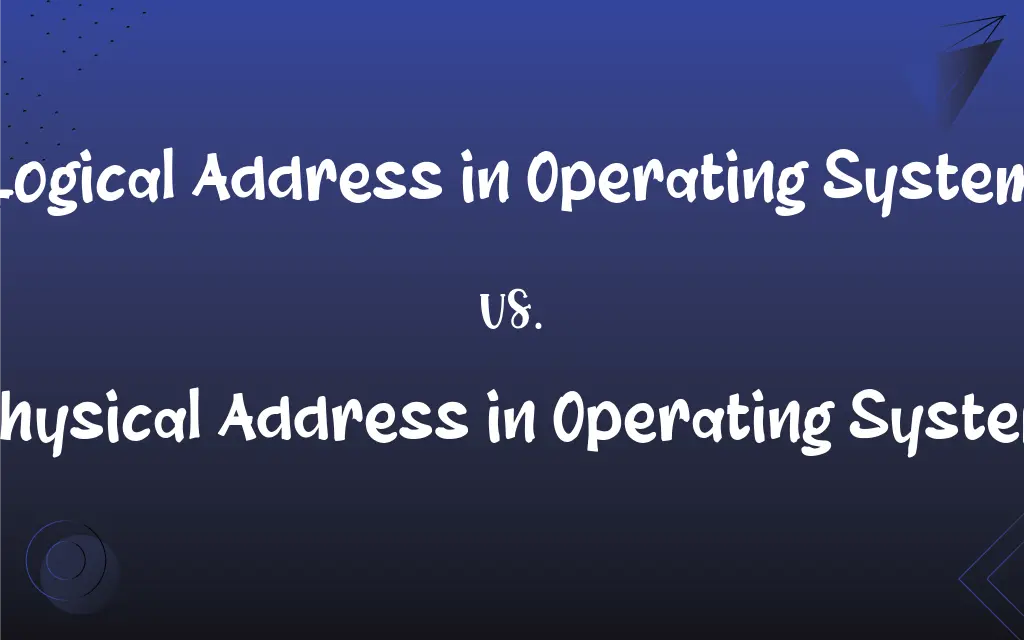Logical Address in Operating System vs. Physical Address in Operating System: What's the Difference?
Edited by Aimie Carlson || By Janet White || Published on February 2, 2024
A logical address in an operating system is a reference to data relative to the program's view, whereas a physical address refers to the actual location in the computer's memory.

Key Differences
In an operating system, a logical address represents a location from the perspective of an executing program, often seen as virtual memory. The physical address, however, is the actual location in the computer's memory hardware. The operating system and the memory management unit (MMU) work together to map these logical addresses to their corresponding physical addresses.
Logical addresses provide a layer of abstraction, allowing programs to operate as if they have access to a large, continuous block of memory. Physical addresses, on the other hand, correspond to the real memory locations on the RAM. This distinction is crucial for efficient memory management and program execution in an operating system.
The use of logical addresses allows the operating system to implement virtual memory, a feature that makes the system appear to have more memory than physically available. Physical addresses are used by the hardware to access the actual memory cells where data is stored.
Logical addressing helps in isolating the memory spaces of different programs, enhancing security and stability. Physical addressing directly deals with the hardware, where such isolation is managed by the operating system's memory management policies.
When a process is executed, it uses logical addresses to access memory. These are then translated to physical addresses by the operating system for actual data retrieval or storage, ensuring that processes do not interfere with each other's memory space.
ADVERTISEMENT
Comparison Chart
Definition
Reference to data relative to the program's view.
Actual location in memory hardware.
Function
Used for abstraction in program memory access.
Used for actual memory hardware access.
Memory Management
Managed by the operating system for efficiency.
Directly correlates to RAM locations.
Role in Virtual Memory
Allows implementation of virtual memory.
Actual addresses where virtual memory is mapped.
Security and Isolation
Enhances security by isolating memory spaces.
Managed by OS to maintain security and stability.
ADVERTISEMENT
Logical Address in Operating System and Physical Address in Operating System Definitions
Logical Address in Operating System
A logical address is a virtual memory reference as seen by a program.
The program accessed variable 'X' using a logical address in its own memory space.
Physical Address in Operating System
OS translates logical addresses to physical addresses for data access.
When a program runs, its logical addresses are mapped to physical addresses in RAM.
Logical Address in Operating System
Logical addresses are translated into physical addresses by the OS.
The OS uses a page table to translate the logical address to a physical one.
Physical Address in Operating System
Physical addressing is crucial for direct memory access.
Hardware devices use physical addresses for reading and writing data.
Logical Address in Operating System
Logical addresses are used in the context of virtual memory.
The logical address pointed to a location in the virtual memory, not actual RAM.
Physical Address in Operating System
Physical addresses correspond to real memory hardware.
The physical address points to a specific cell in the computer's memory.
Logical Address in Operating System
Logical addressing enables easier and safer memory management.
Logical addresses prevent programs from accidentally modifying system memory.
Physical Address in Operating System
Physical addresses are managed by the OS for memory security.
The OS controls which physical addresses are accessible by each process.
Logical Address in Operating System
Logical addresses allow programs to believe they have a large, contiguous memory space.
In logical addressing, two consecutive variables may not be physically contiguous.
Physical Address in Operating System
A physical address refers to an actual memory location in RAM.
The CPU accessed data at the physical address 0x1A2B3C4D.
FAQs
What is a logical address in an OS?
It's a virtual address used by programs to access memory.
What role do logical addresses play in virtual memory?
They allow programs to use more memory than physically available.
Why are logical addresses used?
They provide a simple and secure way for programs to access memory.
Can two programs have the same logical address?
Yes, each program can have similar logical addresses, mapped to different physical addresses.
How does an OS manage logical addresses?
The OS translates these addresses to physical addresses for actual memory access.
Why is address translation important?
It ensures that programs access the correct memory locations.
How does virtual memory relate to physical addresses?
Virtual memory is mapped to physical addresses by the OS.
Are physical addresses constant?
They remain constant for the duration of the program's execution.
Who uses physical addresses?
The operating system and hardware use physical addresses for data access.
How does the OS ensure security with physical addresses?
The OS restricts access to physical addresses based on process permissions.
What is address translation?
It's the process of converting logical to physical addresses.
Do logical addresses change?
Yes, they can change each time the program runs.
Can logical addresses lead to memory fragmentation?
No, logical addresses help in avoiding fragmentation issues.
Do all operating systems use logical addressing?
Most modern operating systems use some form of logical addressing.
Is understanding logical and physical addresses important for programmers?
Yes, it helps in understanding memory management and system operations.
What is a physical address in an OS?
It's the actual location in the computer's RAM.
How is a physical address different from a logical one?
A physical address refers to an actual memory location, unlike the virtual logical address.
Are physical addresses visible to user programs?
No, user programs typically work with logical addresses.
What happens if a program tries to access an illegal physical address?
The OS typically stops the program to prevent unauthorized access.
How does hardware interact with physical addresses?
Hardware components like the CPU access memory using physical addresses.
About Author
Written by
Janet WhiteJanet White has been an esteemed writer and blogger for Difference Wiki. Holding a Master's degree in Science and Medical Journalism from the prestigious Boston University, she has consistently demonstrated her expertise and passion for her field. When she's not immersed in her work, Janet relishes her time exercising, delving into a good book, and cherishing moments with friends and family.
Edited by
Aimie CarlsonAimie Carlson, holding a master's degree in English literature, is a fervent English language enthusiast. She lends her writing talents to Difference Wiki, a prominent website that specializes in comparisons, offering readers insightful analyses that both captivate and inform.
































































